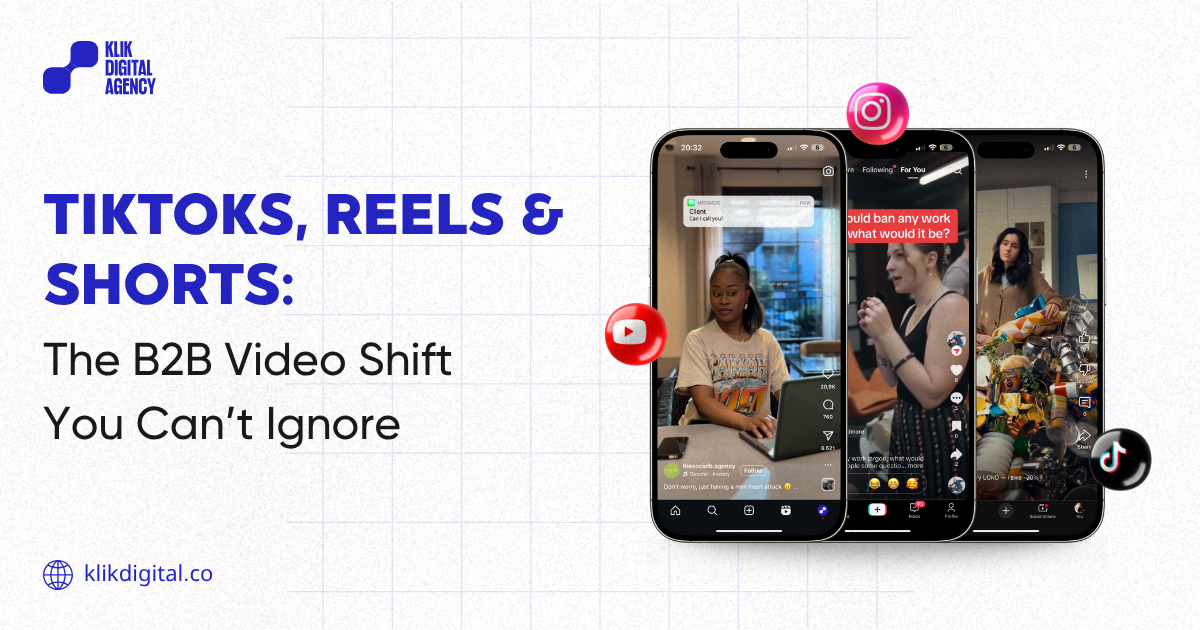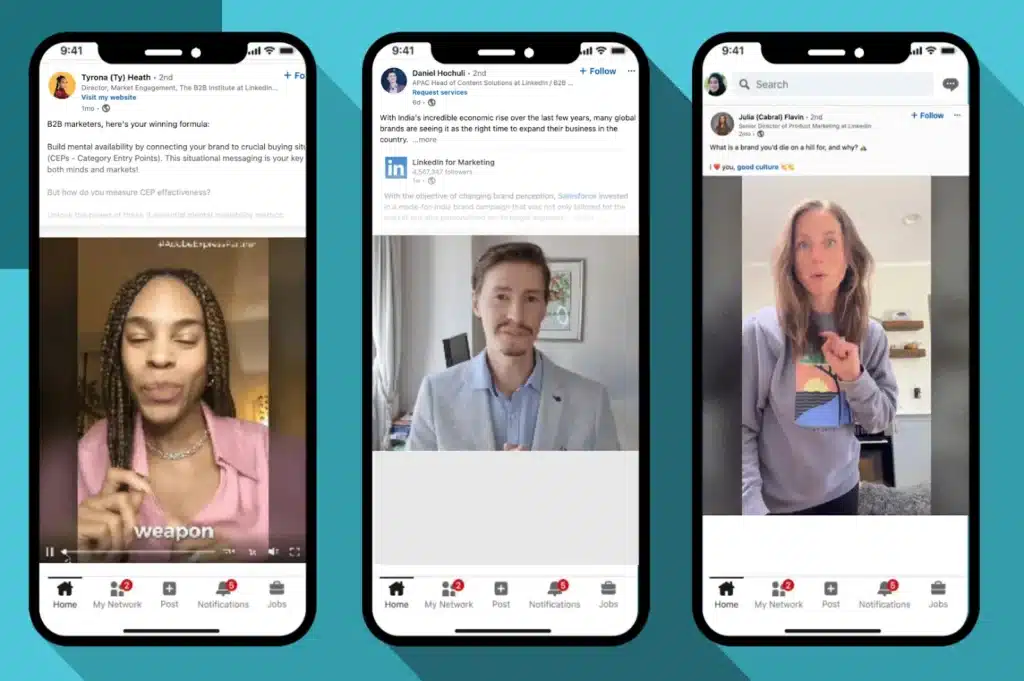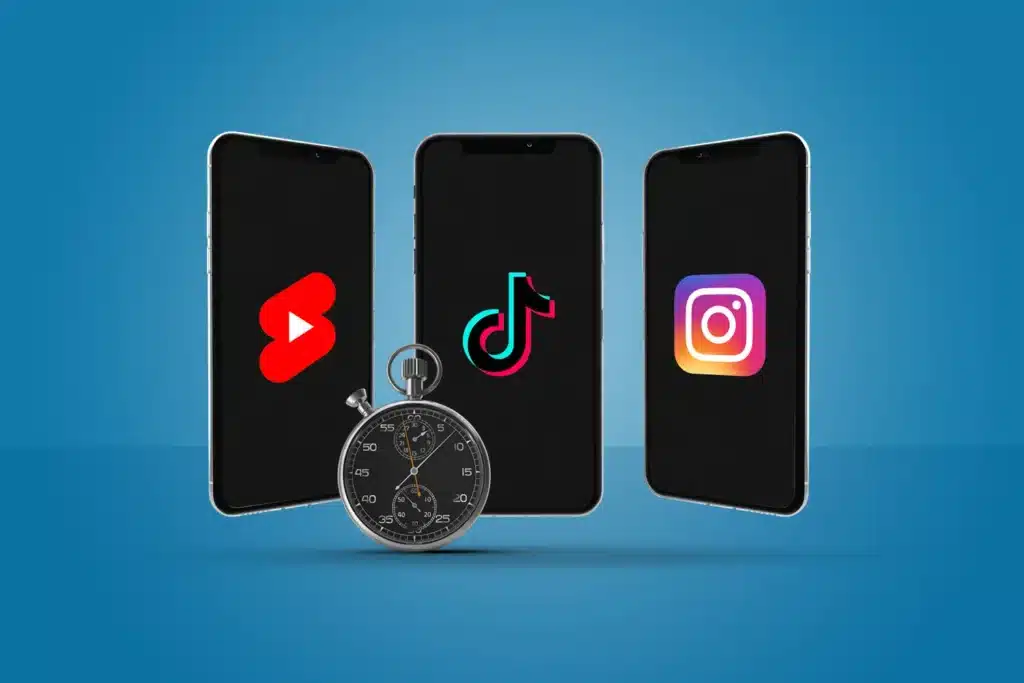TikToks, Reels and Shorts: The B2B Video Shift You Can’t Ignore
Subscribe to our newsletter
Keep up with the latest news in the digital marketing arena with Klik Digital. Subscribe Now!

Remember when TikTok was just for dance challenges and Instagram Reels were only about travel vlogs? Those days are long gone. What started as a consumer entertainment phenomenon has rapidly transformed into a powerful, undeniable force in the business world, especially for B2B brands.
From Entertainment to Enterprise
We’re talking about short-form video: the snappy, digestible content format that dominates feeds across TikTok, Instagram Reels, and YouTube Shorts. For a long time, B2B marketers largely ignored these platforms, seeing them as too “fluffy” or “consumer-focused” for serious business conversations. But in 2025, that mindset is not just outdated—it’s a missed opportunity. Your B2B buyers are scrolling, watching, and engaging with short-form video just like everyone else. And the brands that understand this shift are seeing real, tangible returns. If your B2B company isn’t thinking about short-form video, you simply can’t afford to sit this one out.
Why Short-Form Video Works for B2B
It might seem counterintuitive. How can a 15-60 second clip explain complex software or a nuanced service offering? The magic lies in its ability to cut through the noise and connect on a different level.
Here’s why B2B short-form video isn’t just a trend, but a strategic necessity:
- Humanizes Your Brand: B2B buying decisions are still made by people. Short-form video allows your audience to see the faces behind the logo, hear the voices of your experts, and get a glimpse of your company culture. This builds trust, relatability, and genuine connection in a way that whitepapers often can’t.
- Delivers Complex Ideas Quickly: You don’t need an hour-long webinar to convey a key concept. Short, focused videos can break down intricate processes, highlight critical features, or explain industry jargon in a visually engaging and easily digestible format. Think of it as micro-learning tailored for busy professionals.
- Outperforms Static Content in Reach and Engagement: The algorithms on TikTok, Instagram, and YouTube heavily favor video content. This means your short-form videos are more likely to be seen by new audiences, often extending far beyond your existing followers. Plus, their interactive nature (likes, shares, comments) drives higher engagement rates compared to static images or text posts.

B2B Buyers Are Changing—So Should Your Content
The lines between B2B and B2C content consumption are blurring. Today’s decision-makers, whether they’re a CTO evaluating cloud solutions or an HR leader researching payroll systems, are also consumers in their personal lives. They’re scrolling through TikToks and Reels for entertainment and information, and they expect the same kind of digestible, authentic, and fast-value content from the brands they consider for business.
Short-form video can strategically impact every stage of the buyer journey:
- Top-of-Funnel (TOFU): Awareness and Discovery. Catch attention with quick industry tips, myth-busting, or behind-the-scenes glimpses that introduce your brand to a broad audience.
- Middle-of-Funnel (MOFU): Consideration and Education. Offer bite-sized “how-to” guides, feature highlights, or quick answers to common pain points. This builds authority and showcases expertise.
- Bottom-of-Funnel (BOFU): Decision and Conversion. Share rapid-fire customer success stories, quick testimonials, or compelling calls to action that drive deeper engagement, like a demo request or a resource download.
What Kind of Content Performs?
Thinking your B2B industry is too “boring” for short-form video? Think again. The key is creativity and understanding what resonates in this format.
High-performing B2B short-form video content often includes:
- Quick How-Tos and Product Walkthroughs: Show, don’t just tell. Demonstrate a specific feature of your software, a quick tip for using your service, or a simple solution to a common industry problem. (e.g., “3-step guide to setting up your CRM dashboard”).
- Behind-the-Scenes and Culture Videos: Give your audience a peek behind the curtain. Introduce team members, show your office environment, highlight company values, or share moments from team-building events. This builds rapport and trust.
- Industry Tips, Myth-Busting, and Thought Leadership Snippets: Condense complex industry insights into concise, engaging clips. Challenge common misconceptions or offer unique perspectives that position your brand as a leader.
- Customer Success Stories in 60 Seconds or Less: Leverage testimonials and case studies by showcasing a customer’s problem, your solution, and their quick, positive outcome. This builds social proof efficiently.
The goal isn’t necessarily viral fame, but consistent, valuable content that builds an audience and nurtures leads.

Platform Breakdown: TikTok vs. Reels vs. Shorts
While the content format is similar, each platform has its nuances. Understanding these differences can help you tailor your strategy and maximize your reach.
| Feature | TikTok | Instagram Reels | YouTube Shorts |
| Primary Audience | Gen Z, younger millennials (but growing across all ages for B2B) | Millennials, Gen Z, visually-driven audiences, existing Instagram community | Broad (YouTube’s vast existing user base), younger skew for Shorts |
| Algorithm Strength | Discovery-focused, pushes content to new users aggressively | Favors engagement, often prioritizes content from accounts users already follow or similar interests | Integrated with YouTube ecosystem, strong for discoverability within Youtube/recommendations |
| Max Length | Up to 10 minutes (though 15-60s is ideal for B2B engagement) | 90 seconds (short & snappy works best) | 60 seconds (requires vertical format) |
| Captioning Needs | Less emphasis on long captions; rely on on-screen text/voiceover | Captions matter for context/SEO; often auto-generated captions are used | Critical for SEO; usually auto-generated. Descriptions matter for context. |
| B2B Best Use | Brand humanization, trendjacking, educational quick tips, thought leadership | Behind-the-scenes, quick tips, product demos, culture, cross-promotion with static posts | Evergreen educational content, quick tutorials, product highlights, driving traffic to longer videos |
Repurposing Best Practices: Don’t create unique content for every platform. Shoot once, then tailor. For example, a 60-second tip can be posted on all three. Add platform-specific text overlays, trending audio (where appropriate and relevant), and CTAs.
B2B Success Stories
Don’t just take our word for it. B2B brands are already crushing it:
- Adobe: Uses Reels and TikTok to showcase quick tutorials for Creative Cloud products, appealing to both individual creators and design teams within businesses. Their “how-to” content is highly shareable and directly relevant to their user base.
- Mailchimp: Leverages Instagram Reels to highlight features, share marketing tips for small businesses, and humanize their brand with behind-the-scenes content of their quirky office culture.
- SAP: Yes, even enterprise software giant SAP has a TikTok presence! They use it for employer branding, highlighting company culture, and sharing digestible explainers of complex concepts, proving that even “boring” industries can succeed.
- Monday.com: Their short-form videos on various platforms often feature quick tips on project management, team collaboration, and even humorous takes on common workplace frustrations, showing the practical application of their platform in relatable scenarios.
These examples show that authenticity, utility, and a willingness to experiment are key.
How to Get Started: Lean but Impactful
Feeling overwhelmed? You don’t need a huge budget or a full production studio to start.
- Start with Your Existing Content: Your blog posts, whitepapers, FAQs, and even sales call snippets are goldmines. Break them down into micro-content ideas. A single blog post might yield 5-10 short video concepts.
- Script Lightly, Shoot Vertically, Keep It Real: This isn’t about Hollywood productions. Authenticity trumps polish. Use your phone, shoot in vertical (9:16) aspect ratio, and focus on clear audio and good lighting. A simple outline or bullet points are often better than a rigid script.
- Tools: Leverage accessible editing tools. CapCut and Descript are fantastic for quick edits, adding text overlays, and even AI-powered transcriptions. Canva can help with graphic overlays. And don’t underestimate the native editors within TikTok, Instagram, and YouTube for quick on-the-fly edits and trending audio.
Metrics That Matter
Beyond vanity metrics like views, focus on what truly indicates impact for B2B:
- Watch Time/Completion Rate: Are people watching your videos all the way through? This signals strong engagement and relevance.
- Click-Through Rate (CTR): If you include a link in your bio or caption (where allowed), are people clicking through to your landing pages, demos, or longer content?
- Comment Quality and DMs: Are people asking questions, seeking more information, or engaging in meaningful conversations? Direct messages (DMs) are often direct signals of interest.
- Follower Growth (Relevant): Are you attracting followers who fit your ideal customer profile?
- Tracking Conversions: Ultimately, can you tie short-form video engagement back to leads, MQLs, SQLs, and ultimately, pipeline influence? Use UTM parameters and track your funnel closely.
The landscape of B2B marketing is constantly evolving, and embracing short-form video is no longer an option—it’s a necessity for connecting with modern buyers. Don’t let perceived complexity hold you back. Start small, experiment, and watch your B2B brand thrive in this dynamic new frontier.
Ready to unlock the power of short-form video for your B2B business? Book a Strategy Call to Launch Your Video Funnel.
FAQ:

Yes, absolutely. B2B buyers are consumers, too, and they’re on these platforms. Short-form video helps humanize your brand, explain complex topics quickly, and significantly boost reach and engagement compared to static content.
ROI can manifest in increased brand awareness, improved website traffic, higher engagement rates, more qualified leads, and ultimately, accelerated sales cycles. Direct attribution can be challenging, but its role in the top and middle of the funnel is undeniable for nurturing modern buyers.
Consistency is key. Aim for at least 2-3 times per week to stay relevant in the algorithms, but prioritize quality over quantity. Start with what’s manageable for your team and scale up as you see results.
Yes, you should! Create content once and repurpose it. Shoot a vertical video, then tailor it slightly for each platform by adjusting captions, adding platform-specific features (like trending audio on TikTok/Reels), and optimizing for each audience.
No industry is truly boring if you find the right angle. Focus on solving common pain points, breaking down complex concepts, sharing quick “how-to” tips, showcasing your company culture, or debunking industry myths. Authenticity and utility trump “glamour” in B2B.








